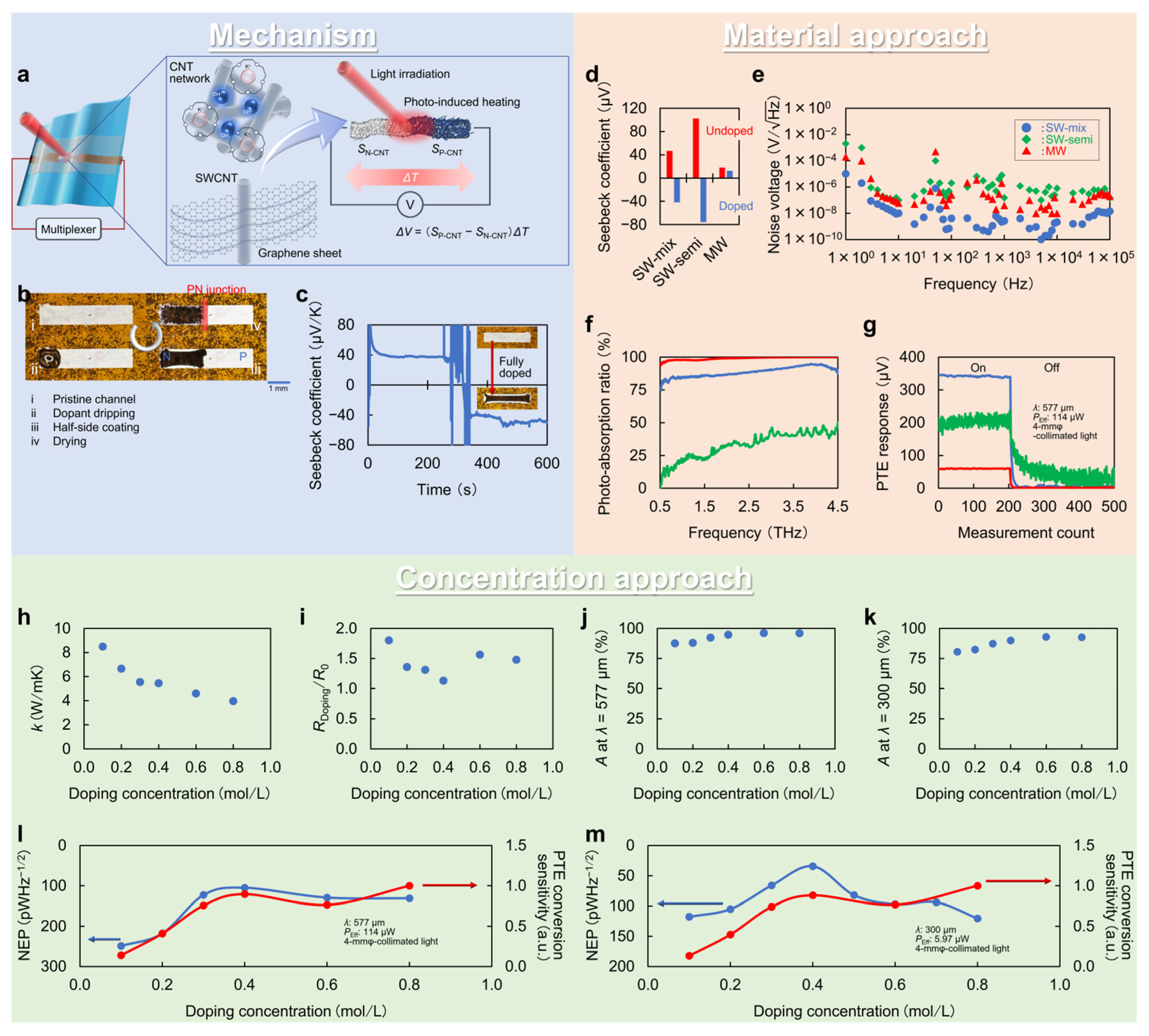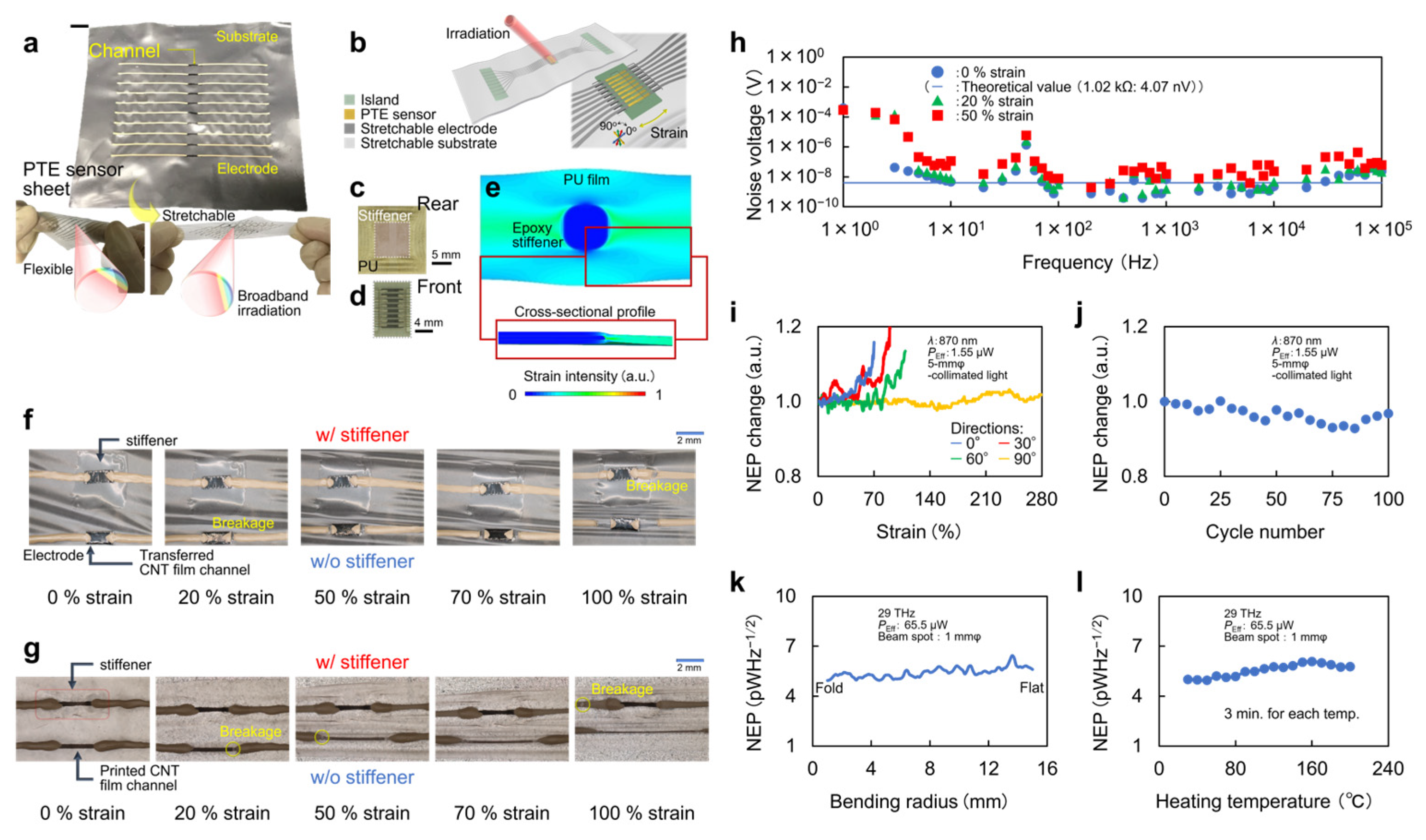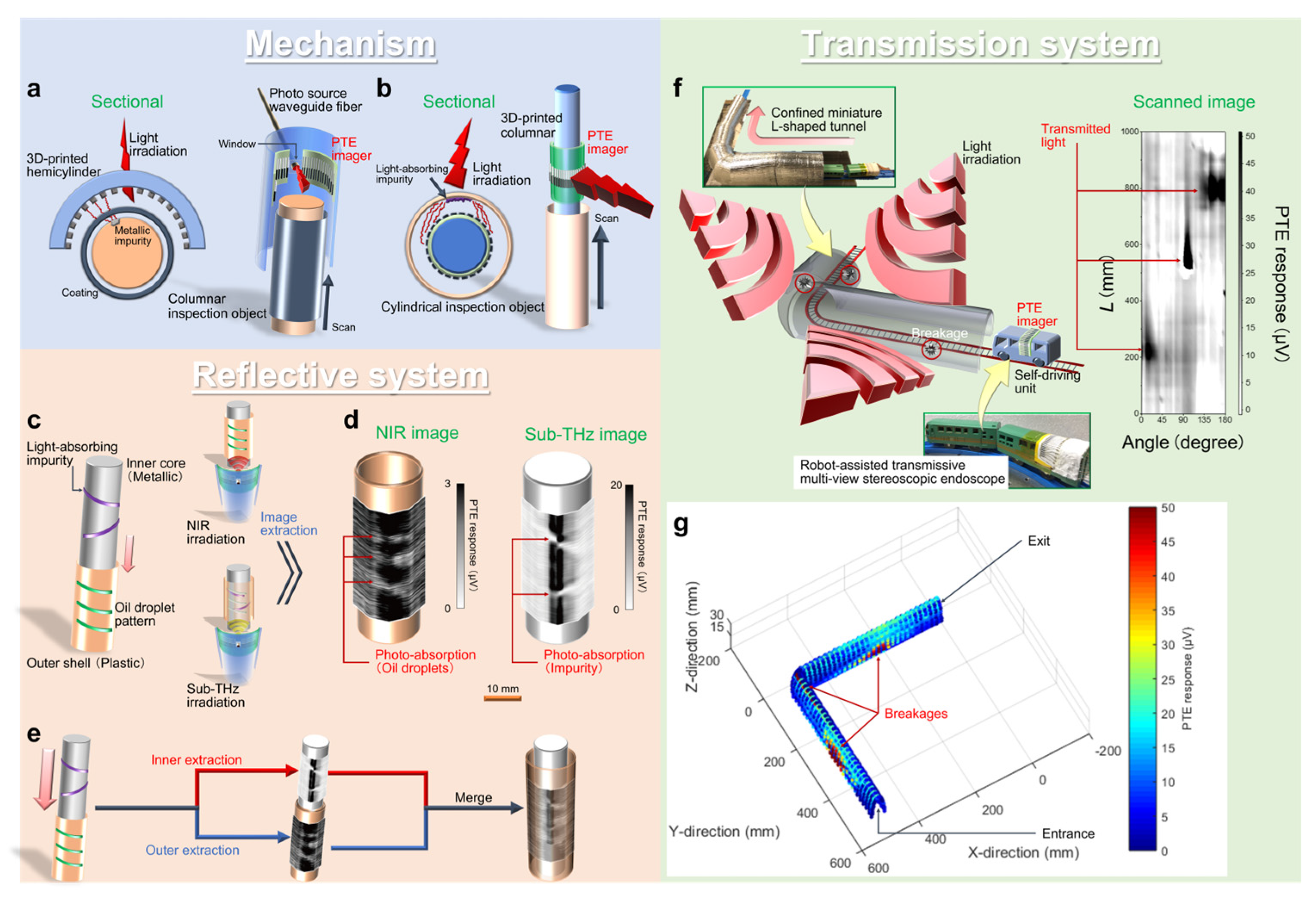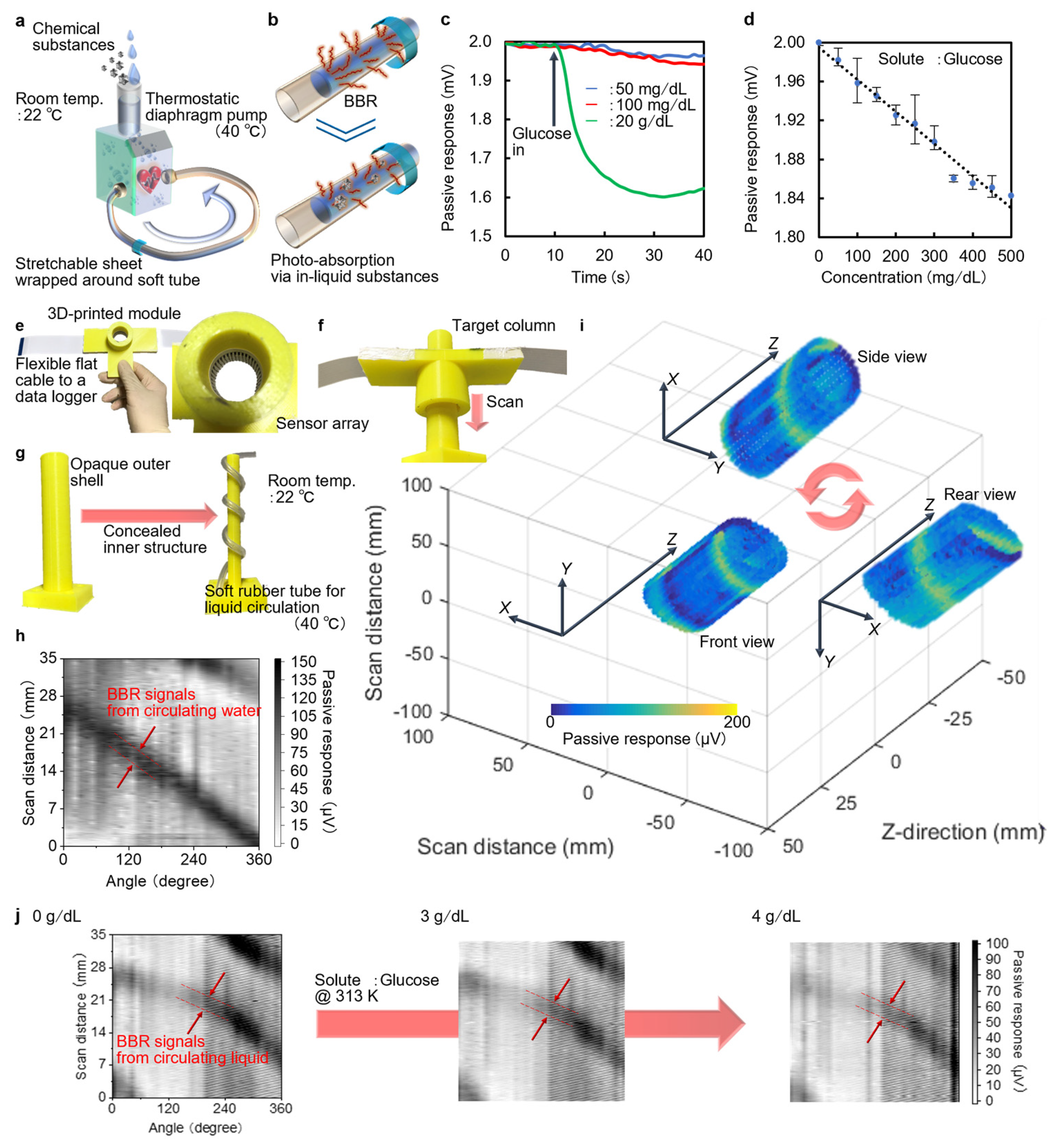Recent Progress in Development of Carbon-Nanotube-Based Photo-Thermoelectric Sensors and Their Applications in Ubiquitous Non-Destructive Inspections
Abstract
:1. Introduction
2. Sensor Material: CNT Films
3. PTE Effect in Channel–Electrode Junctions
3.1. Structural and Material Approach
3.2. Size Approach
3.3. Performances
4. PTE Effect in PN Junctions
4.1. Mechanism
4.2. Material Approach
4.3. Concetration Approach
5. Applications: Ubiquitous Non-Destructive Inspections
5.1. Mechanical Durability and Optical Stability
5.1.1. Stretchability
5.1.2. Flexibility
5.1.3. Thermal Property
5.2. Active Imaging
5.2.1. Mechanism
5.2.2. Reflective System
5.2.3. Transmission System
5.3. Passive Imaging
6. Conclusions
Author Contributions
Funding
Institutional Review Board Statement
Informed Consent Statement
Data Availability Statement
Acknowledgments
Conflicts of Interest
References
- Kawase, K.; Ogawa, Y.; Watanabe, Y.; Inoue, H. Non-destructive terahertz imaging of illicit drugs using spectral fingerprints. Opt. Express 2003, 11, 2549–2554. [Google Scholar] [CrossRef] [PubMed] [Green Version]
- Nishino, K.; Subpa-asa, A.; Asano, Y.; Shimano, M.; Sato, I. Variable ring light imaging: Capturing Transient Subsurface Scattering with an Ordinary Camera. In Proceedings of the European Conference on Computer Vision, Munich, Germany, 8–14 September 2018; pp. 598–613. [Google Scholar]
- Mathews, P.J.; Campbell, Q.P.; Xu, H.; Halleck, P. A review of the application of X-ray computed tomography to the study of coal. Fuel 2017, 209, 10–24. [Google Scholar] [CrossRef]
- Furukawa, T.; Suyama, T.Q.; Li, K.; Sato, I.; Kawano, K. Internal Structure Visualization by Terahertz Computed Tomography with Carbon Nanotube Photo-Scanner toward Multi-Frequency Image Reconstruction. In Proceedings of the IEEE Asia-Pacific Microwave Conference, Brisbane, Australia, 28 November–1 December 2021; pp. 341–343. [Google Scholar]
- Wada, S.; Li, K.; Sun, M.; Utaki, R.; Kawano, Y. Three-Dimensional Shape Reconstruction in Millimeter-Terahertz Wave Regions with Carbon Nanotube Film Array Scanners. In Proceedings of the International Topical Meeting on Microwave Photonics, Piscataway, NJ, USA, 24–26 November 2020; pp. 264–266. [Google Scholar]
- Wang, B.; Zhong, S.; Lee, T.L.; Fancey, K.S.; Mi, J. Non-destructive testing and evaluation of composite materials/structures: A state-of-the-art review. Adv. Mech. Eng. 2020, 12, 1–28. [Google Scholar] [CrossRef] [Green Version]
- Tao, Y.H.; Fitzgerald, A.J.; Wallace, V.P. Non-Contact, Non-Destructive Testing in Various Industrial Sectors with Terahertz Technology. Sensors 2020, 20, 712. [Google Scholar] [CrossRef] [PubMed] [Green Version]
- Aryan, P.; Sampath, S.; Sohn, H. An Overview of Non-Destructive Testing Methods for Integrated Circuit Packaging Inspection. Sensors 2018, 18, 1981. [Google Scholar] [CrossRef] [Green Version]
- Ciampa, F.; Mahmoodi, P.; Pinto, F.; Meo, M. Recent Advances in Active Infrared Thermography for Non-Destructive Testing of Aerospace Components. Sensors 2018, 18, 609. [Google Scholar] [CrossRef] [PubMed] [Green Version]
- Tonouchi, M. Cutting-edge terahertz technology. Nat. Photon. 2007, 1, 97–105. [Google Scholar] [CrossRef]
- Ong, H.C.; Chen, W.H.; Singh, Y.; Gan, Y.Y.; Chen, C.Y.; Show, P.L. A state-of-the-art review on thermochemical conversion of biomass for biofuel production: A TG-FTIR approach. Energy Convers. Manag. 2020, 209, 112634. [Google Scholar] [CrossRef]
- Han, S.P.; Ko, H.; Park, J.W.; Kim, N.; Yoon, Y.J.; Shin, J.H.; Kim, D.Y.; Lee, D.H.; Park, K.H. InGaAs Schottky barrier diode array detector for a real-time compact terahertz line scanner. Opt. Express 2013, 21, 25874–25882. [Google Scholar] [CrossRef]
- Tohmé, L.; Blin, S.; Ducournau, G.; Nouvel, P.; Coquillat, D.; Hisatake, S.; Nagatsuma, T.; Pénarier, A.; Varani, L.; Knap, W.; et al. Terahertz wireless communication using GaAs transistors as detectors. Electron. Lett. 2014, 50, 323–325. [Google Scholar] [CrossRef]
- Boubanga-Tombet, S.; Teppe, F.; Torres, J.; Moutaouakil, A.E.; Coquillat, D.; Dyakonova, N.; Consejo, C.; Arcade, P.; Nouvel, P.; Marinchio, H.; et al. Room temperature coherent and voltage tunable terahertz emission from nanometer-sized field effect transistors. Appl. Phys. Lett. 2010, 97, 262108. [Google Scholar] [CrossRef] [Green Version]
- Komiyama, S.; Astafiev, O.; Antonov, V.; Kutsuwa, T.; Hirai, H. A single-photon detector in the far-infrared range. Nature 2000, 403, 405–407. [Google Scholar] [CrossRef] [PubMed]
- Ikushima, K.; Yoshimura, Y.; Hasegawa, T.; Komiyama, S.; Ueda, T.; Hirakawa, K. Photon-counting microscopy of terahertz radiation. Appl. Phys. Lett. 2006, 88, 152110. [Google Scholar] [CrossRef]
- Otani, C.; Taino, T.; Nakano, R.; Hoshino, K.; Shibuya, T.; Myoren, H.; Ariyoshi, S.; Sato, H.; Shimizu, H.M.; Takada, S.; et al. A broad-band THz radiation detector using a Nb-based superconducting tunnel junction. IEEE Trans. Appl. Supercond. 2005, 15, 591–594. [Google Scholar] [CrossRef]
- Cai, X.; Sushkov, A.B.; Suess, R.J.; Jadidi, M.M.; Jenkins, G.S.; Nyakiti, L.O.; Myers-Ward, R.L.; Li, S.; Yan, J.; Gaskill, D.K.; et al. Sensitive room-temperature terahertz detection via the photothermoelectric effect in graphene. Nature Nanotech. 2014, 9, 814–819. [Google Scholar] [CrossRef] [PubMed] [Green Version]
- Lu, X.; Sun, L.; Jiang, P.; Bao, X. Progress of Photodetectors Based on the Photothermoelectric Effect. Adv. Mater. 2019, 31, 1902044. [Google Scholar] [CrossRef]
- He, X.; Fujimura, N.; Lloyd, J.M.; Erickson, K.J.; Talin, A.A.; Zhang, Q.; Gao, W.; Jiang, Q.; Kawano, Y.; Hauge, R.H.; et al. Carbon nanotube terahertz detector. Nano Lett. 2014, 14, 3953–3958. [Google Scholar] [CrossRef]
- Konabe, S.; Yamamoto, T. Valley photothermoelectric effects in transition-metal dichalcogenides. Phys. Rev. B 2014, 90, 075430. [Google Scholar] [CrossRef]
- Basko, D. A Photothermoelectric Effect in Graphene. Science 2011, 334, 610–611. [Google Scholar] [CrossRef] [Green Version]
- Lai, Y.S.; Tsai, C.Y.; Chang, C.K.; Huang, C.Y.; Hsiao, V.K.S.; Su, Y.O. Photothermoelectric Effects in Nanoporous Silicon. Adv. Mater. 2016, 28, 2644–2648. [Google Scholar] [CrossRef]
- Li, K.; Suzuki, D.; Kawano, Y. Series Photothermoelectric Coupling Between Two Composite Materials for a Freely Attachable Broadband Imaging Sheet. Adv. Photonics Res. 2021, 2, 2000095. [Google Scholar] [CrossRef]
- Li, K.; Yuasa, R.; Utaki, R.; Sun, M.; Tokumoto, Y.; Suzuki, D.; Kawano, Y. Robot-assisted, source-camera-coupled multi-view broadband imagers for ubiquitous sensing platform. Nat. Commun. 2021, 12, 3009. [Google Scholar] [CrossRef] [PubMed]
- Li, K.; Araki, T.; Utaki, R.; Tokumoto, Y.; Sun, M.; Yasui, S.; Kurihira, N.; Kasai, Y.; Suzuki, D.; Marteijn, R.; et al. Stretchable broadband photo-sensor sheets for nonsampling, source-free, and label-free chemical monitoring by simple deformable wrapping. Sci. Adv. 2022, 8, eabm4349. [Google Scholar] [CrossRef] [PubMed]
- Cao, A.; Dickrell, P.L.; Sawyer, W.G.; Ghasemi-Nejhad, M.N.; Ajayan, P.M. Super-compressible foamlike carbon nanotube films. Science 2005, 25, 1307–1310. [Google Scholar] [CrossRef] [Green Version]
- Park, S.; Vosguerichian, M.; Bao, Z. A review of fabrication and applications of carbon nanotube film-based flexible electronics. Nanoscale 2013, 5, 1727–1752. [Google Scholar] [CrossRef]
- Kivistö, S.; Hakulinen, T.; Kaskela, A.; Aitchison, B.; Brown, D.P.; Nasibulin, A.G.; Kauppinen, E.I.; Härkönen, A.; Okhotnikov, O.G. Carbon nanotube films for ultrafast broadband technology. Opt. Express 2009, 17, 2358–2363. [Google Scholar] [CrossRef] [Green Version]
- Zhang, D.; Song, Y.; Ping, L.; Xu, S.; Yang, D.; Wang, Y.; Yang, Y. Photo-thermoelectric effect induced electricity in stretchable graphene-polymer nanocomposites for ultrasensitive strain sensing. Nano Res. 2019, 12, 2982–2987. [Google Scholar] [CrossRef]
- Zubair, A.; Wang, X.; Mirri, F.; Tsentalovich, D.E.; Fujimura, N.; Suzuki, D.; Soundarapandian, K.P.; Kawano, Y.; Pasquali, M.; Kono, J. Carbon nanotube woven textile photodetector. Phys. Rev. Mater. 2018, 2, 015201. [Google Scholar] [CrossRef]
- He, M.; Lin, Y.J.; Chiu, C.M.; Yang, W.; Zhang, B.; Yun, D.; Xie, Y.; Lin, Z.H. A flexible photo-thermoelectric nanogenerator based on MoS2/PU photothermal layer for infrared light harvesting. Nano Energy 2018, 49, 588–595. [Google Scholar] [CrossRef]
- Zhong, Y.; Zhang, L.; Linseis, V.; Qin, B.; Chen, W.; Zhao, L.D.; Zhu, H. High-quality textured SnSe thin films for self-powered, rapid-response photothermoelectric application. Nano Energy 2020, 72, 104742. [Google Scholar] [CrossRef]
- Wu, W.; Wang, Y.; Niu, Y.; Wang, P.; Chen, M.; Sun, J.; Wang, N.; Wu, D.; Zhao, Z. Thermal localization enhanced fast photothermoelectric response in a quasi-one-dimensional flexible NbS3 photodetector. ACS Appl. Mater. Interfaces 2020, 12, 14165–14173. [Google Scholar] [CrossRef] [PubMed]
- Zhang, M.; Yeow, J.T.W. A flexible, scalable, and self-powered mid-infrared detector based on transparent PEDOT:PSS/graphene composite. Carbon 2020, 156, 339–345. [Google Scholar] [CrossRef]
- Suzuki, D.; Li, K.; Ishibashi, K.; Kawano, Y. A Terahertz Video Camera Patch Sheet with an Adjustable Design based on Self-Aligned, 2D, Suspended Sensor Array Patterning. Adv. Funct. Mater. 2021, 31, 2008931. [Google Scholar] [CrossRef]
- Hills, G.; Lau, C.; Wright, A.; Fuller, S.; Bishop, M.D.; Srimani, T.; Kanhaiya, P.; Ho, R.; Amer, A.; Stein, Y.; et al. Modern microprocessor built from complementary carbon nanotube transistors. Nature 2019, 572, 595–602. [Google Scholar] [CrossRef] [PubMed]
- Suzuki, D.; Oda, S.; Kawano, Y. A flexible and wearable terahertz scanner. Nat. Photon. 2016, 10, 809–813. [Google Scholar] [CrossRef]
- Li, K.; Suzuki, D.; Ochiai, Y.; Kawano, Y. Sensitivity Enhancement of Photothermoelectric Terahertz Detectors with Series Combination between Carbon Nanotubes and Metals. In Proceedings of the 43rd International Conference on Infrared, Millimeter, and Terahertz Waves, Nagoya, Japan, 9–14 September 2018; pp. 1–2. [Google Scholar]
- Suzuki, D.; Ochiai, Y.; Kawano, Y. Thermal Device Design for a Carbon Nanotube Terahertz Camera. ACS Omega 2018, 3, 3540–3547. [Google Scholar] [CrossRef] [Green Version]
- Leontie, L.; Caraman, M.; Alexe, M.; Harnagea, C. Structural and optical characteristics of bismuth oxide thin films. Surf. Sci. 2002, 507–510, 480–485. [Google Scholar] [CrossRef]
- Völklein, F.; Kessler, E. A Method for the Measurement of Thermal Conductivity, Thermal Diffusivity, and Other Transport Coefficients of Thin Films. Phys. Status Solidi A 1984, 81, 585–596. [Google Scholar] [CrossRef]
- Hatta, I. Thermal diffusivity measurement of thin films by means of an ac calorimetric method. Rev. Sci. Instrum. 1985, 56, 1643. [Google Scholar] [CrossRef]
- Das, V.D.; Soundararajan, N. Size and temperature effects on the Seebeck coefficient of thin bismuth films. Phys. Rev. B 1987, 35, 5990–5996. [Google Scholar] [CrossRef]
- Kosarev, A.; Rumyantsev, S.; Moreno, M.; Torres, A.; Boubanga, S.; Knap, W. SixGey:H-based micro-bolometers studied in the terahertz frequency range. Solid State Electron. 2010, 54, 417–419. [Google Scholar] [CrossRef]
- Zhang, Y.; Watanabe, Y.; Hosono, S.; Nagai, N.; Hirakawa, K. Room temperature, very sensitive thermometer using a doubly clamped microelectromechanical beam resonator for bolometer applications. Appl. Phys. Lett. 2016, 108, 163503. [Google Scholar] [CrossRef]
- Kim, D.Y.; Kenneth, K.O. Reduction of NEP variations for terahertz detectors using Schottky barrier diodes in CMOS. Electron. Lett. 2017, 53, 732–734. [Google Scholar] [CrossRef]
- Li, K.; Utaki, R.; Sun, M.; Kawano, Y. A Highly-Sensitive and Highly-Integrated Flexible Broadband Imager with 3D Printed π-Shaped Photo-Thermoelectric Pixel Structures. In Proceedings of the 45th International Conference on Infrared, Millimeter, and Terahertz Waves, Buffalo, NY, USA, 8–13 November 2020; pp. 1–2. [Google Scholar]
- Nakai, Y.; Honda, K.; Yanagi, K.; Kataura, H.; Kato, T.; Yamamoto, T.; Maniwa, Y. Giant Seebeck coefficient in semiconducting single-wall carbon nanotube film. Appl. Phys. Express 2014, 7, 025103. [Google Scholar] [CrossRef] [Green Version]
- Goldsmid, H.J. Bismuth Telluride and Its Alloys as Materials for Thermoelectric Generation. Materials 2014, 7, 2577–2592. [Google Scholar] [CrossRef] [Green Version]
- Son, J.S.; Park, K.; Han, M.; Kang, C.; Park, S.G.; Kim, J.H.; Kim, W.; Kim, S.; Hyeon, T. Large-Scale Synthesis and Characterization of the Size-Dependent Thermoelectric Properties of Uniformly Sized Bismuth Nanocrystals. Angew. Chem. Int. Ed. 2011, 50, 1363–1366. [Google Scholar] [CrossRef]
- Nonoguchi, Y.; Nakano, M.; Murayama, T.; Hagino, H.; Hama, S.; Miyazaki, K.; Matsubara, R.; Nakamura, M.; Kawai, T. Simple Salt-Coordinated n-Type Nanocarbon Materials Stable in Air. Adv. Funct. Mater. 2016, 26, 3021–3028. [Google Scholar] [CrossRef] [Green Version]
- Nakashima, Y.; Yamaguchi, R.; Toshimitsu, F.; Matsumoto, M.; Borah, A.; Staykov, A.; Islam, S.; Hayami, S.; Fujigaya, T. Air-Stable n-Type Single-Walled Carbon Nanotubes Doped with Benzimidazole Derivatives for Thermoelectric Conversion and Their Air-Stable Mechanism. ACS Appl. Nano Matter. 2019, 2, 4703–4710. [Google Scholar] [CrossRef]
- Yu, C.; Murali, A.; Choi, K.; Ryu, Y. Air-stable fabric thermoelectric modules made of N- and P-type carbon nanotubes. Energy Environ. Sci. 2012, 5, 9481–9486. [Google Scholar] [CrossRef]
- Brownlie, L.; Shapter, J. Advances in carbon nanotube n-type doping: Methods, analysis and applications. Carbon 2018, 126, 252–270. [Google Scholar] [CrossRef]
- Suzuki, D.; Ochiai, Y.; Nakagawa, Y.; Kuwahara, Y.; Saito, T.; Kawano, Y. Fermi-level-controlled semiconducting-separated carbon nanotube films for flexible terahertz imagers. ACS Appl. Nano Matter. 2018, 1, 2469–2475. [Google Scholar] [CrossRef]
- Utaki, R.; Li, K.; Sun, M.; Tokumoto, Y.; Kawano, Y. Carbon Nanotube Film Terahertz Detectors with Multiple PN Junctions. In Proceedings of the 44th International Conference on Infrared, Millimeter, and Terahertz Waves, Paris, France, 1–6 September 2019; pp. 1–2. [Google Scholar]
- Nonoguchi, Y.; Takata, A.; Goto, C.; Kitano, T.; Kawai, T. Thickness-dependent thermoelectric power factor of polymer-functionalized semiconducting carbon nanotube thin films. Sci. Tech. Adv. Mater. 2019, 19, 581–587. [Google Scholar] [CrossRef] [Green Version]
- Suzuki, D.; Kawano, Y. Flexible terahertz imaging systems with single-walled carbon nanotube films. Carbon 2020, 162, 13–24. [Google Scholar] [CrossRef]
- Utaki, R.; Li, K.; Kawano, Y. A Stretchable Wideband Photo-Thermoelectric Wrap Scanner Sheet for Wearable and Noninvasive Liquid Quality Monitoring. In Proceedings of the 45th International Conference on Infrared, Millimeter, and Terahertz Waves, Buffalo, NY, USA, 8–13 November 2020; pp. 1–2. [Google Scholar]
- Tokumoto, Y.; Li, K.; Araki, T.; Harada, Y.; Sekitani, T.; Kawano, Y. Stretchable Terahertz Imagers for Wearable Bio-Monitoring Applications. In Proceedings of the 44th International Conference on Infrared, Millimeter, and Terahertz Waves, Paris, France, 1–6 September 2019; pp. 1–2. [Google Scholar]
- Kang, P.; Wang, M.C.; Knapp, P.M.; Nam, S. Crumpled Graphene Photodetector with Enhanced, Strain-Tunable, and Wavelength-Selective Photoresponsivity. Adv. Mater. 2016, 28, 4639–4645. [Google Scholar] [CrossRef]
- Chinag, C.W.; Haider, G.; Tan, W.C.; Liou, Y.R.; Lai, Y.C.; Ravindranath, R.; Chang, H.T.; Chen, Y.F. Highly stretchable and sensitive photodetectors based on hybrid graphene and graphene quantum dots. ACS Appl. Mater. Interfaces 2016, 8, 466–471. [Google Scholar] [CrossRef]
- Xu, X.; Zuo, Y.; Cai, S.; Tao, X.; Zhang, Z.; Zhou, X.; He, S.; Fang, X.; Peng, H. Three-dimensional helical inorganic thermoelectric generators and photodetectors for stretchable and wearable electronic devices. J. Mater. Chem. C 2018, 6, 4866–4872. [Google Scholar] [CrossRef]
- Yang, X.; Vorobiev, A.; Generalov, A.; Andersson, M.A.; Stake, J. A flexible graphene terahertz detector. Appl. Phys. Lett. 2017, 111, 021102. [Google Scholar] [CrossRef] [Green Version]
- Capasso, F. High-performance midinfrared quantum cascade lasers. Opt. Eng. 2010, 49, 111102. [Google Scholar] [CrossRef]
- Maekawa, T.; Kanaya, H.; Suzuki, S.; Asada, M. Oscillation up to 1.92 THz in resonant tunneling diode by reduced conduction loss. Appl. Phys. Express 2016, 9, 024101. [Google Scholar] [CrossRef]
- Sharma, S.K.; Kim, D.Y. Design, simulation, fabrication, packaging and testing of an AlGaAs/GaAs Gunn diode at 94 GHz. J. Korean Phys. Soc. 2015, 67, 619–624. [Google Scholar] [CrossRef]
- Waterhouse, D.J.; Joseph, J.; Neves, A.A.; Pietro, M.D.; Brindle, K.M.; Fitzgerald, R.C.; Bohndiek, S.E. Design and validation of a near-infrared fluorescence endoscope for detection of early esophageal malignancy. J. Biomed. Opt. 2016, 21, 084001. [Google Scholar] [CrossRef]
- Doradla, P.; Alavi, K.; Joseph, C.S.; Giles, R.H. Single-channel prototype terahertz endoscopic system. J. Biomed. Opt. 2014, 19, 080501. [Google Scholar] [CrossRef] [Green Version]
- Shur, M. Subterahertz and Terahertz Sensing of Biological Objects and Chemical Agents. In Proceedings of SPIE 10531, Terahertz, RF, Millimeter, and Submillimeter-Wave Technology and Applications XI; SPIE: Bellingham, WA, USA, 2018; p. 1053108. [Google Scholar]
- Li, K.; Yuasa, R.; Utaki, R.; Sun, M.; Tokumoto, Y.; Suzuki, D.; Kawano, Y. Multi-view Terahertz Imagers with Flexible Carbon Nanotube Film Arrays. In Proceedings of the 44th International Conference on Infrared, Millimeter, and Terahertz Waves, Paris, France, 1–6 September 2019; pp. 1–2. [Google Scholar]
- Laschi, C.; Cianchetti, M.; Mazzolai, B.; Margheri, L.; Follador, M.; Dario, P. Soft robot arm inspired by the octopus, advanced robotics. Adv. Robot. 2012, 26, 709–727. [Google Scholar] [CrossRef]
- Koh, K.H.; Sreekumar, M.; Ponnambalam, S.G. Hybrid electrostatic and elastomer adhesion mechanism for wall climbing robot. Mechatronics 2016, 35, 122–135. [Google Scholar] [CrossRef]
- Yang, L.; Wang, Q.; Vong, C.; Zhang, L. A miniature flexible-link magnetic swimming robot with two vibration modes: Design, modeling and characterization. IEEE Robot. Autom. Lett. 2017, 2, 2024–2031. [Google Scholar] [CrossRef]
- Tomić, T.; Ott, C.; Haddadin, S. External Wrench estimation, collision detection, and reflex reaction for flying robots. IEEE Trans. Robot. 2017, 33, 1467–1482. [Google Scholar] [CrossRef]
- Liu, T.K.; Sheu, H.Y.; Tseng, C.N. Environmental impact assessment of seawater desalination plant under the framework of integrated coastal management. Desalination 2013, 326, 10–18. [Google Scholar] [CrossRef]
- Rehfeldt, S.; Stichlmair, J. Measurement and prediction of multicomponent diffusion coefficients in four ternary liquid systems. Fluid Phase Equilib. 2010, 290, 1–14. [Google Scholar] [CrossRef]
- Restrepo, C.E.; Simonoff, J.S.; Zimmerman, R. Causes, cost consequences, and risk implications of accidents in US hazardous liquid pipeline infrastructure. Int. J. Crit. Infr. Prot. 2009, 2, 38–50. [Google Scholar] [CrossRef]
- Bruzzoniti, M.C.; Carlo, R.M.D.; Sarzanini, C.; Maina, R.; Tumiatti, V. Determination of copper in liquid and solid insulation for large electrical equipment by ICP-OES. Application to copper contamination assessment in power transformers. Talanta 2012, 99, 703–711. [Google Scholar] [CrossRef]
- Raunkjær, K.; Jacobsen, T.W.; Nielsen, P.H. Measurement of pools of protein, carbohydrate and lipid in domestic wastewater. Water Res. 1994, 28, 251–262. [Google Scholar] [CrossRef]
- Stachniuk, A.; Formal, E. Liquid chromatography-mass spectrometry in the analysis of pesticide residues in food. Food Anal. Methods 2016, 9, 1654–1665. [Google Scholar] [CrossRef] [Green Version]
- Costa, A.C.O.; Perfeito, L.D.S.; Tavares, M.F.M.; Micke, G.A. Determination of sorbate and benzoate in beverage samples by capillary electrophoresis—Optimization of the method with inspection of ionic mobilities. J. Chromatogr. A 2008, 1204, 123–127. [Google Scholar] [CrossRef] [PubMed]
- Al-Faqheri, W.; Thio, T.H.G.; Qasaimeh, M.A.; Dietzel, A.; Madou, M.; Al-Halhouli, A. Particle/cell separation on microfluidic platforms based on centrifugation effect: A review. Microfluid. Nanofluid. 2017, 21, 102. [Google Scholar] [CrossRef]
- Nguyen, C.V.; Nguyen, A.V.; Doi, A.; Dinh, E.; Nguyen, T.V.; Ejtemaei, M.; Osborne, D. Advanced solid-liquid separation for dewatering fine coal tailings by combining chemical reagents and solid bowl centrifugation. Sep. Purif. Technol. 2021, 259, 118172. [Google Scholar] [CrossRef]
- Piao, X.M.; Cha, E.J.; Yun, S.J.; Kim, W.J. Role of exosomal miRNA in bladder cancer: A promising liquid biopsy biomarker. Int. J. Mol. Sci. 2021, 22, 1713. [Google Scholar] [CrossRef]
- Kaya, T.; Liu, G.; Ho, J.; Yelamarthi, K.; Miller, K.; Edwards, J.; Stannard, A. Wearable sweat sensors: Background and current trends. Electroanalysis 2019, 31, 411–421. [Google Scholar] [CrossRef]
- Gallo, P.; Fabbrocino, S.; Dowling, G.; Salini, M.; Fiori, M.; Perretta, G.; Serpe, L. Confirmatory analysis of non-steroidal anti-inflammatory drugs in bovine milk by high-performance liquid chromatography with fluorescence detection. J. Chromatogr. A 2010, 1217, 2832–2839. [Google Scholar] [CrossRef]
- Wen, X.; Yang, Q.; Yan, Z.; Deng, Q. Determination of cadmium and copper in water and food samples by dispersive liquid–liquid microextraction combined with UV–vis spectrophotometry. Microchem. J. 2011, 97, 249–254. [Google Scholar] [CrossRef]
- Deng, X.; Li, L.; Enomoto, M.; Kawano, Y. Continuously frequency-tuneable plasmonic structures for terahertz bio-sensing and spectroscopy. Sci. Rep. 2019, 9, 3498. [Google Scholar] [CrossRef]
- Qu, Z.; Jiang, P.; Zhang, W. Development and Application of Infrared Thermography Non-Destructive Testing Techniques. Sensors 2020, 20, 3851. [Google Scholar] [CrossRef] [PubMed]
- Sun, M.; Li, K.; Utaki, R.; Kawano, Y. Multi-Wavelength-Coupled in-Line Pharmaceutical Monitoring Inspections with Photo-Thermoelectric Device Design of Broadband Image Sensor Array Sheets. In Proceedings of the 45th International Conference on Infrared, Millimeter, and Terahertz Waves, Buffalo, NY, USA, 8–13 November 2020; pp. 1–2. [Google Scholar]
- Sun, M.; Li, K.; Tokumoto, Y.; Utaki, R.; Kawano, Y. Remote Selective Liquid Inspection with Carbon Nanotube Terahertz Imagers. In Proceedings of the 44th International Conference on Infrared, Millimeter, and Terahertz Waves, Paris, France, 1–6 September 2019; pp. 1–2. [Google Scholar]
- Rogalski, A. Semiconductor detectors and focal plane arrays for far-infrared imaging. Opto Electron. Rev. 2013, 21, 406–426. [Google Scholar] [CrossRef] [Green Version]
- Crane, P.K.; Walker, R.; Hubbard, R.A.; Li, G.; Nathan, D.M.; Zheng, H.; Haneuse, S.; Craft, S.; Montine, T.J.; Kahn, S.E.; et al. Glucose levels and risk of dementia. N. Engl. J. Med. 2013, 369, 540–548. [Google Scholar] [CrossRef] [PubMed] [Green Version]
- Li, Z.; Zhu, Y.; Zhang, W.; Xu, C.; Pan, Y.; Zhao, Y. A low-cost and high sensitive paper-based microfluidic device for rapid detection of glucose in fruit. Food Anal. Methods 2017, 10, 666–674. [Google Scholar] [CrossRef]







Disclaimer/Publisher’s Note: The statements, opinions and data contained in all publications are solely those of the individual author(s) and contributor(s) and not of MDPI and/or the editor(s). MDPI and/or the editor(s) disclaim responsibility for any injury to people or property resulting from any ideas, methods, instructions or products referred to in the content. |
© 2022 by the authors. Licensee MDPI, Basel, Switzerland. This article is an open access article distributed under the terms and conditions of the Creative Commons Attribution (CC BY) license (https://creativecommons.org/licenses/by/4.0/).
Share and Cite
Li, K.; Kinoshita, Y.; Sakai, D.; Kawano, Y. Recent Progress in Development of Carbon-Nanotube-Based Photo-Thermoelectric Sensors and Their Applications in Ubiquitous Non-Destructive Inspections. Micromachines 2023, 14, 61. https://doi.org/10.3390/mi14010061
Li K, Kinoshita Y, Sakai D, Kawano Y. Recent Progress in Development of Carbon-Nanotube-Based Photo-Thermoelectric Sensors and Their Applications in Ubiquitous Non-Destructive Inspections. Micromachines. 2023; 14(1):61. https://doi.org/10.3390/mi14010061
Chicago/Turabian StyleLi, Kou, Yuya Kinoshita, Daiki Sakai, and Yukio Kawano. 2023. "Recent Progress in Development of Carbon-Nanotube-Based Photo-Thermoelectric Sensors and Their Applications in Ubiquitous Non-Destructive Inspections" Micromachines 14, no. 1: 61. https://doi.org/10.3390/mi14010061
APA StyleLi, K., Kinoshita, Y., Sakai, D., & Kawano, Y. (2023). Recent Progress in Development of Carbon-Nanotube-Based Photo-Thermoelectric Sensors and Their Applications in Ubiquitous Non-Destructive Inspections. Micromachines, 14(1), 61. https://doi.org/10.3390/mi14010061





